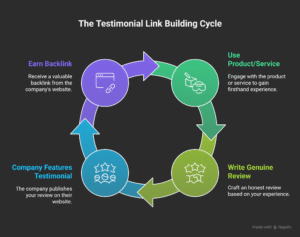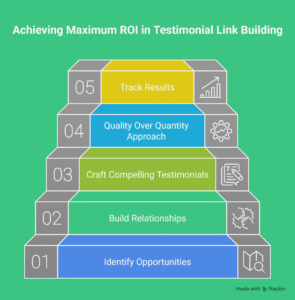Seeking safe, high-authority backlinks that Google trusts? Testimonial link building offers a powerful, ethical strategy that most marketers completely ignore. This comprehensive guide reveals exactly how to implement this proven tactic to boost your SEO rankings without violating Google’s guidelines.
What Is Testimonial Link Building?
Testimonial link building involves writing genuine reviews for products or services you actually use—earning valuable backlinks when companies feature your testimonials on their websites. This white-hat strategy creates mutual value: companies gain credible social proof while you earn authoritative links.
Unlike manufactured link schemes, testimonial link building operates on authentic business relationships. You’re sharing real experiences with tools that genuinely improved your business outcomes. The resulting backlinks emerge naturally as companies showcase customer success stories.

Why Companies Actively Seek Testimonials
According to HubSpot’s 2024 Consumer Trust Report, 89% of consumers trust peer recommendations over traditional advertising. This drives companies to actively collect and display customer testimonials because they:
- Increase conversion rates by up to 34%: Social proof directly influences purchasing decisions
- Build brand credibility: Real user feedback establishes trust with potential customers
- Provide authentic content: User-generated testimonials offer genuine perspectives that resonate with prospects
- Improve search visibility: Fresh testimonial content enhances page relevance and user engagement signals
SEO Benefits That Drive Results
For website owners and SEO professionals, testimonial link building delivers measurable advantages:
- High-authority link placements: Testimonials often appear on homepages and key product pages
- Natural do-follow links: Companies typically provide followed links to enhance testimonial credibility
- Industry-relevant backlinks: Links come from tools and services within your niche
- Long-term relationship building: Initial testimonials can lead to ongoing partnerships and collaboration opportunities
- Brand authority enhancement: Featured testimonials increase your visibility and credibility within your industry
“The best link building strategies provide genuine value to both parties. Testimonial links work because they’re based on real relationships and authentic experiences.” – Brian Dean, Backlinko
Is Testimonial Link Building Safe in 2025?
With Google’s March 2024 Core Update emphasizing helpful, people-first content, understanding algorithm compliance is crucial for any link building strategy.
Google’s Official Stance on Editorial Links
According to Google’s Link Spam Guidelines, the search engine distinguishes between manipulative schemes and naturally earned editorial links. Testimonial links qualify as editorial when they’re voluntarily placed by companies to enhance their credibility.
Google specifically targets:
- Reciprocal link exchanges: “Link to me, I’ll link to you” arrangements
- Purchased links: Direct payment for link placement
- Artificial link networks: Manufactured relationships designed solely for SEO
- Irrelevant cross-linking: Links between unrelated industries or topics
Authentic testimonials avoid these violations because companies choose to feature them based on genuine value, not SEO manipulation.
2025 Compliance Best Practices
To ensure your testimonial link building remains compliant with current guidelines:
- Never request specific link attributes: Let companies decide on do-follow/no-follow status
- Avoid testimonial exchanges: Don’t arrange mutual testimonial swaps with other businesses
- Maintain authentic experiences: Only provide testimonials for products you genuinely use
- Focus on value creation: Ensure your testimonial helps potential customers make informed decisions
- Respect natural timing: Spread testimonial outreach over several months to maintain natural patterns
Key Insight: Google’s algorithms evaluate link context, relevance, and natural acquisition patterns. Testimonial links excel in all three areas when implemented authentically.
Step-by-Step Implementation Guide of Testimonial Link Building
Transform your existing business relationships into valuable backlink opportunities with this systematic approach.
Audit Your Current Tool Stack
Start with authenticity by documenting every tool and service your business actively uses. Review your:
- Software subscriptions: Check billing statements for SaaS tools, plugins, and platforms
- Service providers: Hosting, email marketing, CRM, and analytics platforms
- Hardware purchases: Equipment, cameras, microphones, and productivity tools
- Educational resources: Online courses, training platforms, and certification programs
- Freelance platforms: Upwork, Fiverr, or specialized industry marketplaces
Research Testimonial Opportunities
Not every company actively features customer testimonials. Conduct thorough research to identify the most promising targets:
- Homepage analysis: Look for customer quote sections, logos, or featured reviews
- Dedicated testimonial pages: Search for “/testimonials”, “/reviews”, or “/customers” URLs
- Case study sections: Companies often feature detailed customer success stories
- Product page reviews: Check if they showcase user feedback on specific features
- Social proof indicators: Customer logos, satisfaction scores, or trust badges
Use Ahrefs Site Explorer to analyze whether featured testimonials include do-follow links back to customer websites.
Craft High-Impact Testimonials
Transform your user experience into compelling social proof that companies want to feature prominently:
- Include specific metrics: “Increased conversion rates by 23%” beats “great results”
- Address common objections: Tackle price concerns, feature limitations, or implementation challenges
- Mention specific features: Highlight particular tools or capabilities that delivered value
- Provide context: Explain your role, company size, or industry for relevant social proof
- Keep it concise: Aim for 50-75 words for maximum usability
Example of an effective testimonial:
“As a content manager for a 50-person SaaS company, Ahrefs helped us identify 340% more ranking opportunities than our previous tool. The Content Gap feature alone saved 15 hours per week on competitor research. Worth every penny for serious content teams looking to scale efficiently.”
Execute Strategic Outreach
Approach companies with a value-first mentality using this proven email template:
Subject: Quick testimonial for [Product Name] Hi [Name], I wanted to share how [Product/Service] has impacted our business over the past [timeframe]. We've seen [specific result] and found [particular feature] especially valuable. I'd be happy to provide a testimonial if it would be helpful: "[Your compelling testimonial]" - [Your Name], [Title] at [Company] - [Website URL] - [Optional: Professional headshot link] Feel free to edit as needed. Thanks for building such a useful tool! Best regards, [Your Name]
“The most successful link building happens when you’re not actively trying to build links. Focus on providing value, and links follow naturally.” – Rand Fishkin, SparkToro
Industry Performance Data
Research from SEMrush’s 2024 Link Building Report reveals testimonial link building effectiveness across industries:
- Technology sector: 67% testimonial acceptance rate, average DR 45 linking domains
- Marketing services: 59% acceptance rate, average DR 38 linking domains
- E-commerce tools: 71% acceptance rate, average DR 52 linking domains
- Educational platforms: 64% acceptance rate, average DR 41 linking domains
Advanced Optimization Strategies
Maximize your testimonial link building ROI with these proven enhancement techniques.

Quality Over Quantity Approach
Focus on high-impact opportunities rather than mass outreach:
- Target industry leaders: Prioritize well-known brands in your niche for maximum authority transfer
- Analyze competitor backlinks: Use SEMrush to identify where competitors have testimonial links
- Evaluate link placement: Homepage and product page testimonials carry more SEO weight than buried testimonial pages
- Consider brand association: Being featured alongside recognizable companies enhances your credibility
Multi-Format Testimonial Strategy
Diversify your testimonial formats to increase placement opportunities:
- Video testimonials: Offer higher perceived value and more prominent placement
- Case study participation: Provide detailed results for comprehensive content pieces
- Quote + logo combinations: Supply branded visuals for enhanced testimonial displays
- Social media testimonials: Create Twitter/LinkedIn posts that companies can embed
Relationship Building Beyond Links
Transform initial testimonials into long-term business relationships:
- Offer beta testing: Volunteer for new feature testing to deepen relationships
- Participate in case studies: Provide detailed success metrics for comprehensive content
- Join customer advisory boards: Contribute strategic input while maintaining visibility
- Speak at company events: Leverage testimonial relationships for speaking opportunities
“In 2025, successful SEO isn’t about gaming algorithms—it’s about building genuine relationships that naturally result in high-quality links.” – Neil Patel, Neil Patel Digital
Essential Tools and Resources
Streamline your testimonial link building process with these proven tools and platforms.
Research and Analysis Tools
- Ahrefs: Analyze competitor testimonial links and domain authority metrics
- SEMrush: Research linking opportunities and track backlink acquisition
- Moz Link Explorer: Evaluate link quality and domain authority scores
- Google Search Console: Monitor referral traffic from testimonial placements
Outreach and Organization
- Hunter.io: Find accurate contact information for marketing teams
- Notion or Airtable: Track outreach campaigns, responses, and link placements
- Google Alerts: Monitor when your testimonials go live online
- Calendly: Schedule follow-up conversations with interested companies
Common Pitfalls and How to Avoid Them
Prevent costly mistakes that can damage your SEO efforts or business relationships.
Critical Mistakes to Avoid
- Fabricating testimonials: Only provide feedback for products you actually use and can speak about authentically
- Copy-pasting testimonials: Customize each testimonial to reflect specific product experiences
- Requesting specific link types: Never ask for do-follow links or specific anchor text
- Ignoring follow-up timing: Wait 2-3 weeks before sending a polite follow-up email
- Neglecting relationship maintenance: Continue engaging with companies beyond the initial testimonial
Quality Control Checklist
Before submitting any testimonial, verify:
- You’ve used the product for at least 30 days
- Specific results or benefits mentioned are accurate
- Testimonial sounds natural and authentic
- Contact information and website details are current
- Professional headshot is high-quality and recent
Frequently Asked Questions
How many testimonials should I submit per month?
Limit yourself to 3-5 testimonials monthly to maintain natural link acquisition patterns. Google’s algorithms can detect unnatural linking spikes that might trigger manual reviews.
What industries respond best to testimonial requests?
B2B SaaS, marketing tools, educational platforms, and business services show the highest acceptance rates. These industries rely heavily on social proof for customer acquisition.
Should I include a professional headshot with my testimonial?
Yes, testimonials with photos receive 73% higher placement rates according to HubSpot’s testimonial research. Visual elements increase credibility and usage likelihood.
How long should I wait before following up?
Send a polite follow-up after 2-3 weeks if you haven’t received a response. Many companies have internal approval processes that require additional time.
Can I modify my testimonial after it’s published?
Contact the company’s marketing team to request updates. Most businesses accommodate reasonable revision requests, especially for factual corrections or updated metrics.
Future-Proofing Your Strategy
Testimonial link building remains effective because it aligns with Google’s core ranking principles: authenticity, user value, and natural relationship building.
As search algorithms continue evolving toward user-first experiences, testimonial links will likely become even more valuable due to their genuine nature and user benefit focus.
To maintain long-term success:
- Prioritize authentic experiences over link acquisition
- Build lasting relationships with companies you genuinely support
- Continuously improve testimonial quality and specificity
- Diversify across multiple industries and company sizes
Conclusion
Testimonial link building represents one of the most ethical and effective link acquisition strategies available in 2025. By sharing genuine experiences with products and services that have truly benefited your business, you create valuable content that companies want to feature while earning high-quality backlinks naturally.
Start by auditing your current tool stack, identify companies that actively showcase testimonials, and craft compelling testimonials that provide real value to potential customers. Focus on authenticity over volume, and build lasting relationships that extend far beyond initial link placements.
The most successful practitioners treat testimonial link building as relationship building first and SEO second. When you provide genuine value through honest feedback and detailed success stories, the backlinks become a natural byproduct of helping companies build trust with their prospects.


